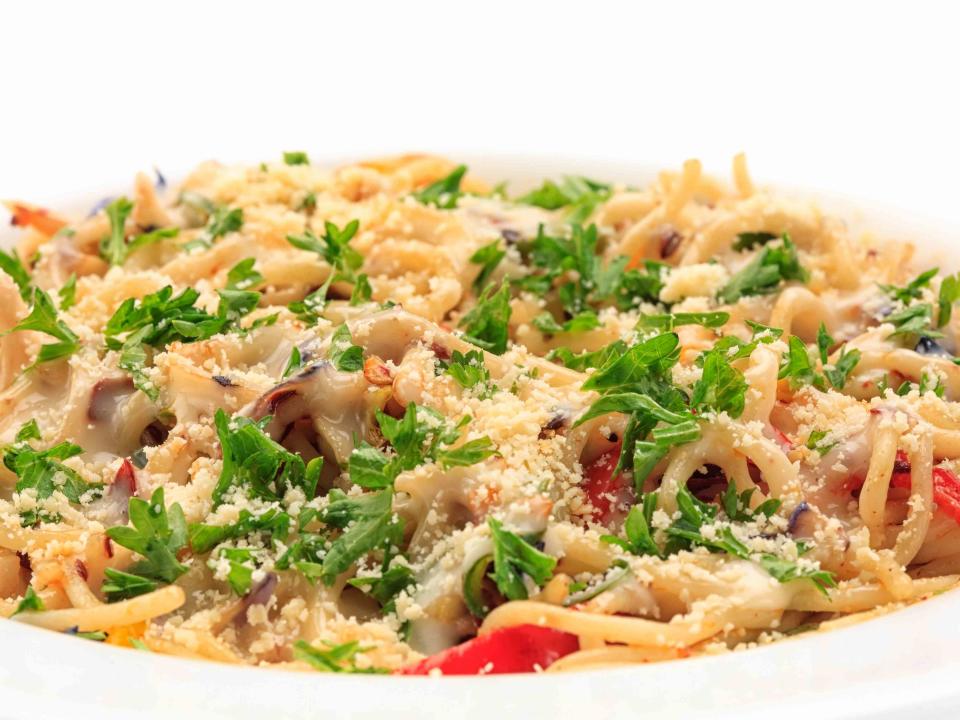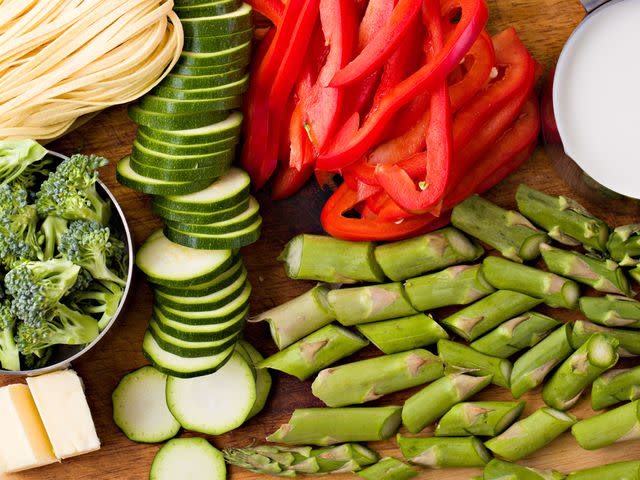The Classic 70s Pasta Dish I'm Making All Summer Long
This retro entree is the perfect way to savor the season.

DrRave/Getty Images
I’m not convinced that there’s a dish that exemplifies the food aesthetic of the late 70s to early 80s better than the legendary pasta primavera. Originally developed to showcase spring’s vegetable and herbal bounty, in the comforting guise of creamy pasta, primavera took the U.S. by storm. It quickly moved from “fine dining” to casual to virtually ubiquitous. And though you’d be forgiven for assuming that it’s an ancient recipe brought over from Italy, the reality is that it’s as American as apple pie.
Pasta Primavera History
Sirio Macione, the legendary genius behind New York’s once-in-a-generation restaurant Le Cirque was, according to legend, at a vacation house far from civilization with some friends who had grown tired of the fish and game that they’d been catching and cooking. They begged Sirio to come up with something lighter. (I have to laugh, because this dish — though fresh and delicious — is anything but light.) It was an amalgam of pasta, vegetables, herbs, garlic, butter, cheese, and cream. Naturally, a sensation was born. What we now know as pasta primavera (actually, “spaghetti primavera” at the beginning) was codified in the The New York Times in 1975, and an edition of Craig Claiborne’s New York Times Cookbook a bit later.
Related: The Most Popular Recipes of the 1970s
What Is Pasta Primavera?
Basically, the pasta dish relies on a mouthwatering series of vibrant vegetables, blanched separately and shocked in ice water. Garlic is sauteed, pine nuts toasted, tomatoes barely heated, and plenty of cream is added — then herbs, cooked pasta, butter, and a final flourish of Parmigiano. The original vegetable line up included broccoli, zucchini, asparagus, green beans, and peas. Tomatoes, mushrooms, and chillies came along a bit later. Whatever vegetables you include, it is a wow-inducing bowl of pasta.
Related: How to Cook Fresh Pasta
I still make the classic version of the dish on occasion because it is ridiculously tasty. But more frequently, I make a modified version that does not involve separate blanching for all of the vegetables, uses less cream, and totally skips the frighteningly expensive pine nuts (I do have a mortgage to pay, after all!). And, even as someone who fundamentally disagrees with “lightning” classics, my version is still pretty darn good. Plus, it makes this glorious dish approachable for dinner any night of the week.

How to Make Your Own Pasta Primavera
The beauty of pasta primavera is that it is incredibly flexible. As mentioned above, I’ve developed my own “anytime” rendition of the dish that you can adapt even further.
The first change I propose to the classic primavera formula is that you blanch all of your vegetables together, in the same pot of boiling water. Blanching and shocking each vegetable type in a separate batch is an unnecessarily chef-y move. However, you will need to time when you add each vegetable variety to the pot according to how long they need to cook. Nothing will take too long — these are blanched vegetables, after all. Then, you can shock them all together in the same ice bath. And while we’re talking vegetables, don’t be bound by the list above or any recipe; use any that you like, and add as many vegetables as you like.
Related: The 20 Best Pasta Sauces, According to Our Readers
When it comes to herbs, the original pasta primavera used parsley and basil. I do as well, but I also toss in tons of my other favorites: tarragon, chives, thyme, and oregano. The garden is filled with them and, to me, too many herbs is never enough. Again, it’s your call. I’d just avoid using a heavy hand with any of the really strong herbs, like rosemary.
If you want the flavor and crunch of nuts without breaking the bank to buy pine nuts, toast a handful of whatever nuts you have in your freezer. Personally, I would not recommend peanuts, but if that’s your jam, go ahead. And, if you still believe pine nuts are the way to go, buy ones that specify they’re from Italy on the packaging. As someone with awful firsthand knowledge of pine mouth, I strongly advise against the cheaper ones.
When your pasta, of whatever shape, is about halfway done, saute as much garlic as you like in good olive oil until soft. Add chopped tomatoes and a judicious amount of heavy cream (⅓ cup should do it), and then it’s time to toss everything together and warm it all back up a bit. I always reserve some of my chopped herbs to toss in at the end in order to get two different hits of herbal deliciousness. The final addition is a shower (or even thunderstorm, if you prefer) of grated Parmigiano-Reggiano cheese.
Related: Our 15 Most Popular Dinner Party Recipes From the 1970s
While my version is emphatically not the original, it is a very close cousin. And it won't make you feel like you’ve consumed three or four dinners at one sitting. All of the butter and cream involved in classic pasta primavera is great once in a while, so give a fully indulgent recipe a try too. But creating “your own” take on primavera is the best way to enjoy it as often as you crave it!
Pasta Primavera Recipes
If you want a recipe to use as a jumping off point in developing your perfect primavera formula, give one of these a try:

